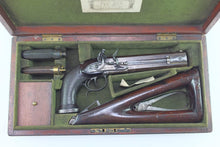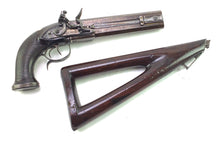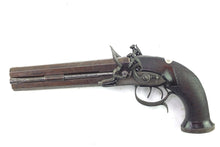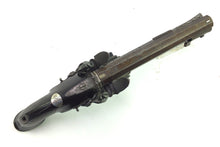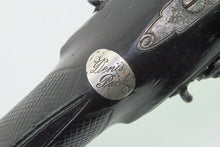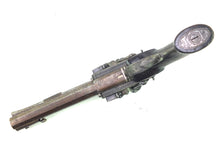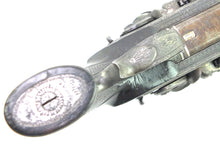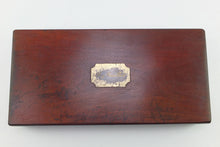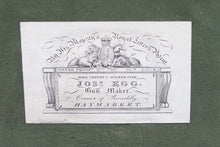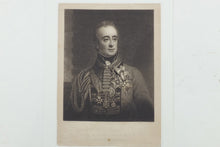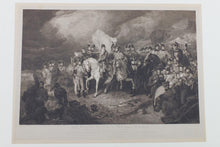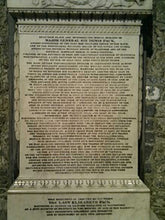
A Very Rare Cased Over and Under Flintlock Officers Pistol with Shoulder Stock by Tatham and Egg inscribed to Brigadier Sir Denis Pack.
Missed out on this item? Click to view all current Antique Pistols & Revolvers. Free UK delivery on all items
Pistol 13 ¾” overall, 8” 18 bore twist octagonal barrels, the upper rifled with eight grooves, fitted on the right hand side with sliding bayonet and on the left with iron ramrod with pineapple chequered finial. The breeches with platinum lines and platinum lined barrelsmith’s stamp, the lower breech rounded, engraved breech tang decorated with border ornament and a Britannia trophy, stepped locks signed ‘Tatham & Egg’ engraved with bouquets on the tails, fitted with 'French' cocks, semi-rainproof pans and bolt safeties. The steel springs with roller, chequered angular butt with shoulder stock escutcheon. The pommel encircled by an engraved iron band, inlaid with a central oval inscribed 'Tatham & Egg Improvement 1009', engraved spurred trigger guard, silver escutcheon engraved 'Denis Pack' complete with skeleton shoulder stock engraved 'Tatham & Egg, London' on the top and with spring catch operated by a lever beneath. In its original mahogany case lined in green baize, with later ‘D. Egg’ label in the lid, with brass escutcheon on the outside engraved 'Brigadier Denis Pack', and complete with original bullet mould, powder flask, priming flask and loading rod.
- 1009, CIRCA 1810. EX the David Jeffcoat Collection (1945-2020)
Fine pistols in good condition. Sold with a print of Dennis Pack and a print of Wellington with his staff.
Sir Denis Pack (c. 1772-1823) was appointed Cornet in the 14th Light Dragoons on 30 November 1791 and he served with a squadron that formed the advance guard of Lord Moira's force in Flanders in 1794. Pack volunteered to carry an important dispatch into Nieuwpoort and had great difficulty in escaping when the French invested it. Later he was engaged at Boxtel and in the winter retreat to Bremen. Following that retreat the 14th squadron was transferred to the 8th Light Dragoons after being attached to it. When Pack came home he obtained his Lieutenancy in the 14th on 12 March 1795. He commanded a small party of Dragoons in the Quiberon expedition, and in this period did duty for some months as a field officer on Isle Dieu. He received his troop in the 5th Dragoon Guards on 27 February 1796, and while serving with them in Ireland in 1798 he led a patrol near Prosperous against a party of rebels, they lost twenty men and eight horses. Pack commanded the escort which conducted General Humbert and other French officers to Dublin after their surrender at Ballinamuck. On 25 August 1798 he was promoted Major in the 4th Royal Irish Dragoon Guards and on 6 December 1800 he was appointed Lieutenant-Colonel in the 71st Highlanders. He commanded the 71st at the recapture of the Cape of Good Hope in 1806 where he was wounded at the landing in Lospard's Bay. During the ill fated operation in South America in 1806-7 he was taken prisoner but he managed to escape. He then commanded the Light Troops of the army in two successful actions against the enemy and in Whitelocke's disastrous attack on Buenos Aires in which he received three wounds. In 1808 the 71st was ordered to Portugal, and he commanded it at the battles of Roliça and Vimeiro. He marched with Sir John Moore's army into Spain and in the retreat to Corunna. After returning to England he took part in the Walcheren expedition in 1809 in which he bravely stormed one of the enemy's batteries during the siege of Flushing. He became Aide-de-Camp to the King with the rank of Colonel on 25 July 1810. He was then appointed with local rank to a Portuguese brigade under Marshal Beresford and commanded it at Busaco in 1810, and in front of Almeida in May 1811. When the French garrison escaped Pack pursued them to Barba del Puerco, and upon orders of Sir Brent Spencer blew up the defences of Almeida. At the capture of Ciudad Rodrigo, Pack, who had been appointed a British Brigadier- Gneral, led his Portuguese brigade to make a feint attack on the outwork of the Santiago gate which was converted into a real attack.
Pack distinguished himself at the battle of Salamanca and was honourably mentioned for his services in the operations against Burgos. He became a Major-General on 4 June 1813 and was present with his brigade at Vitoria. Wellington placed him in temporary command of the 6th division in the Pyrenées, and he was wounded again at Soraven. He commanded a division at the battles of Nivelle, the Nive, Orthez, and Toulouse where he received yet another wound and was honourably mentioned. For his Peninsular services, in which he was eight times wounded, he received the Peninsular Gold Cross and seven clasps. He was offered a brigade in the expedition to America but instead was appointed to command at Ramsgate. He was made KCB on 2 January 1815.
In June 1815 Pack commanded a brigade of Picton's division at Quatre-Bras and Waterloo, where he was again wounded. That was his last foreign service. He married, on 10 July 1816, Lady Elizabeth Louisa Beresford (d. Jan 1856), fourth daughter of the second earl of Waterford, and sister of the first marquess. Pack held the orders of the Tower and Sword in Portugal, Maria Theresa in Austria, and St Vladimir in Russia. He was appointed colonel of the York chasseurs in 1816, Lieutenant-Governor of Plymouth on 12 August 1819, and colonel of the 84th Foot on 9 September 1822. Pack died at Lord Beresford's house in Upper Wimpole Street, London, on 24 July 1823. In 1828 his widow erected a monument to him, surmounted by a marble bust by Chantrey, in the cathedral church of St Canice, Kilkenny, of which his father had been Dean. (Taken from the Oxford Dictionary of National Biography, accessed 29th March 2021.)

















